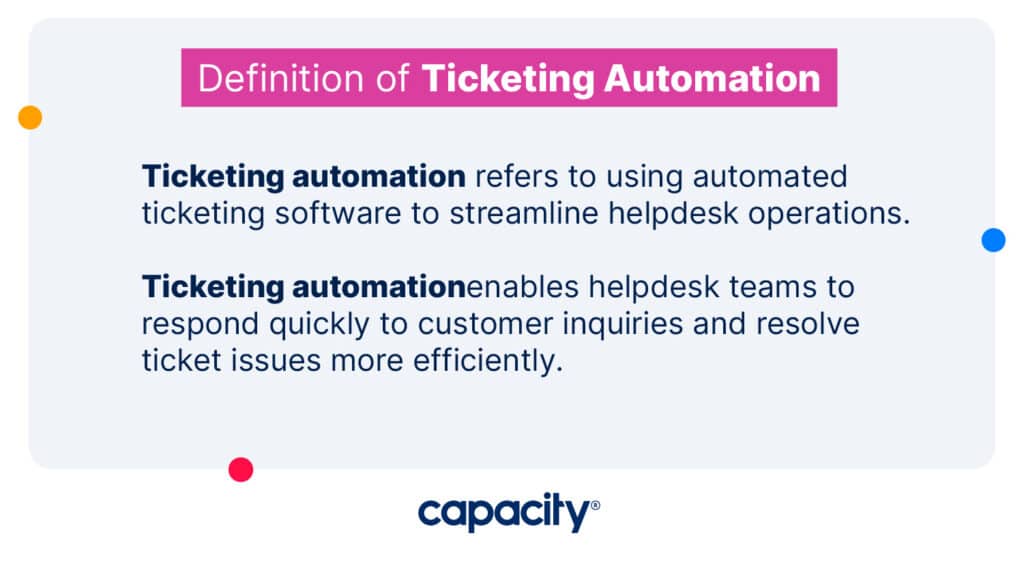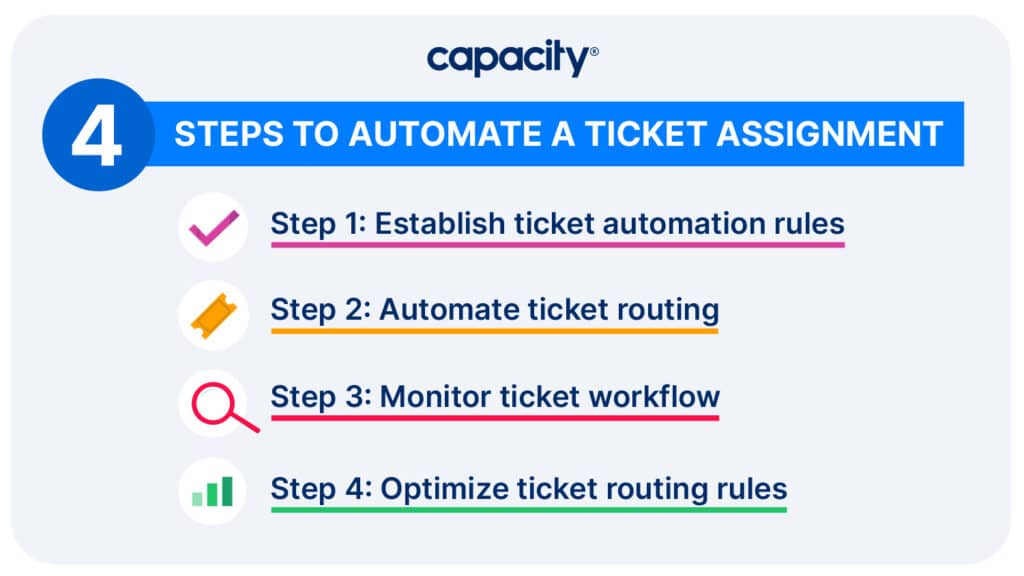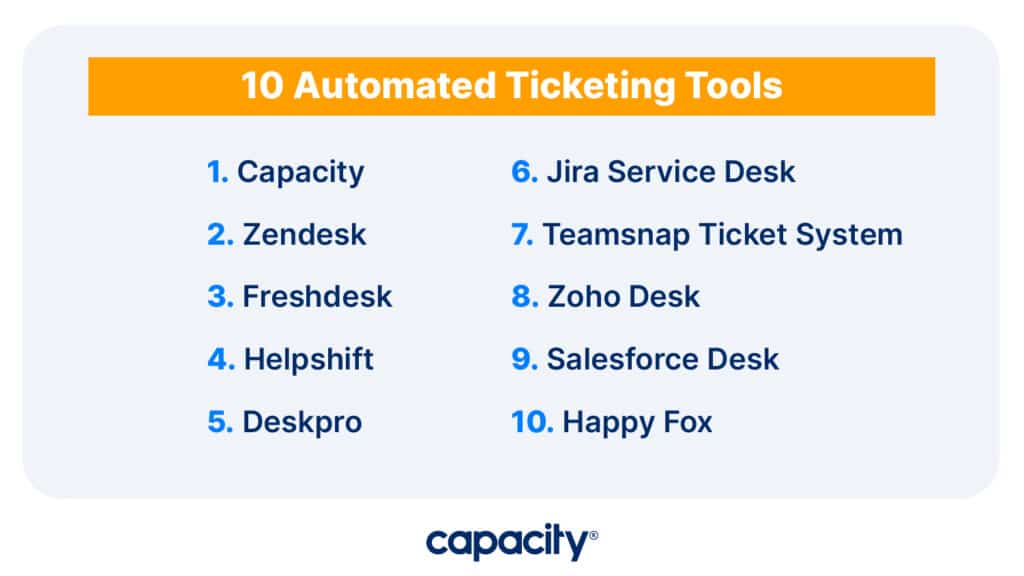What is ticketing automation?
Ticketing automation refers to using automated ticketing software to streamline help desk operations. This system enables helpdesk teams to respond quickly to customer inquiries and resolve ticket issues more efficiently. It also helps save time and money by reducing manual labor costs associated with ticket processing, such as manually entering ticket information into a ticketing system. By taking advantage of ticketing automation, help desk teams can focus more on providing quality customer service and less on tedious ticket-management tasks.

4 steps to automate a ticket assignment
If you want to implement ticket automation into your helpdesk operations, there are a few steps you can take to start thinking about automating some of the tedious work, especially those Tier 0 questions that come in all day, every day.

Step 1: Establish ticket automation rules
First, create ticket automation rules determining how ticket assignments should be handled. Depending on the ticketing system, this may involve setting up specific assignment criteria to ensure tickets are assigned to the right helpdesk team members. For example, the ticketing system could be configured to automatically assign ticket inquiries about specific products to the product’s support team.
Step 2: Automate ticket routing
Next, configure ticket routing rules that assign incoming requests to the appropriate help desk team members. This can include automated ticket assignments based on ticket type, priority level, or customer profile. Once ticket requests are routed to the appropriate helpdesk team, ticket processing and resolution can begin.
Want to automate your work?
Start for free today.
Step 3: Monitor ticket workflow
Now that ticket routing is automated, help desk teams need to monitor ticket workflow to ensure tickets are being processed efficiently. This could involve setting up ticket progress tracking software or using ticketing system analytics to track how long ticket requests are processed and resolved.
Step 4: Optimize ticket routing rules
Finally, use ticket analytics data to optimize ticket routing rules. Helpdesk teams can adjust ticket automation settings based on customer needs and preferences by continually monitoring ticket workflow and analyzing ticket data. This helps ensure tickets are always assigned to the right team members.
Which ticketing automation tool is best?

When it comes to ticketing automation, there is no one-size-fits-all solution. Depending on the size and scope of your help desk operations, different ticketing automation tools may offer highly beneficial features for you. Consider evaluating several ticketing systems options before deciding which is best for your business. Here are 10 automated ticketing systems to consider:
1. Capacity: This ticket automation platform is designed to help teams reduce their ticket processing time by providing automated ticket assignment, routing, and management capabilities.
Pros: Get started for free, Automated ticket classification, intuitive ticket routing, ticket views, and ticket tracking features.
Cons: Limited ticket customization options, but they are coming.
2. Zendesk: This ticketing automation software has many features, from automated ticket assignment to customizable ticket fields.
Pros: Easy setup and integration; powerful ticket routing capabilities; excellent customer support.
Cons: Expensive when compared to other ticketing automation solutions.
3. Freshdesk: This ticket automation platform is designed for customer service teams of all sizes.
Pros: User-friendly ticket routing and assignment; detailed ticket analytics; free basic version.
Cons: Limited ticket views and limited automation features.
4. Helpshift: This ticketing system offers a range of help desk ticketing solutions for mobile apps, including automated ticket classification and routing.
Pros: Excellent ticket assignment; powerful automation features; accessible from mobile devices.
Cons: Limited ticket views and ticket tracking features.
5. Deskpro: This ticketing automation software is built for enterprise customer service teams, emphasizing scaling ticket processing needs.
Pros: Automated ticket routing; advanced ticket analytics; ticket tracking capabilities.
Cons: Complex ticket setup process and limited customization options.
6. Jira Service Desk: This ticket automation software is designed for agile teams and offers ticket automation features, such as ticket routing and ticket tracking capabilities.
Pros: Easy ticket setup process; automated ticket assignment; powerful ticket analytics.
Cons: Minimal opportunities for personalization and restricted ticket perspectives.
7. Teamsnap Ticket System: This ticketing software offers several automation features, including intelligent routing and comprehensive tracking of every ticket.
Pros: Easy ticket setup process; automated ticket assignment; powerful ticket analytics.
Cons: Minimal opportunities for personalization and restricted perspectives when viewing tickets.
8. Zoho Desk: This ticket automation platform is designed for customer service teams of all sizes with features like automated ticket assignment and ticket routing capabilities.
Pros: Excellent customer support; ticket views and tracking features; automated ticket classification.
Cons: Few ticket analytics tools are available.
9. Salesforce Desk: This ticket automation software is designed for enterprise customer service teams with features like ticket routing, tracking, and powerful ticket analytics capabilities.
Pros: Automated ticket assignment; intuitive ticket routing; ticket views and ticket tracking features.
Cons: Complex ticket setup process and limited customization options.
10. HappyFox: This ticket automation software comes with various help desk ticketing solutions for customer service teams, including automated ticket classification and ticket routing capabilities.
Pros: Automated ticket assignment; intuitive ticket routing; ticket views and ticket tracking features.
Cons: Scant options for tracking ticket sales.

3 benefits of an automated ticketing system
Automated ticketing systems provide numerous advantages for customer service teams. They can reduce the ticket processing time by eliminating manual ticket assignment, routing, and management processes. Here are 4 advantages that automating ticketing offers over manual ticket routing.
1. Tackle and deflect a high volume of tickets faster
The capacity to organize and catalog all customer requests is an unmistakable benefit of utilizing a support ticket system. This becomes even more crucial for enterprises that must manage high inquiries. Not only does it help agents quickly take care of cases, but it also reduces the likelihood that some will go unresolved. Moreover, since tickets have priority levels attached, helpdesk personnel can decide which needs attention first, eliminating the need to address all queries simultaneously.
2. Keep your tickets and exchanges in one place
Modern ticketing systems are designed to provide a comprehensive and streamlined experience, even when your customers contact you via multiple channels. With it, all customer interactions will be consolidated into one thread – so whether your customer contacts you through your website or calls in for help doesn’t matter – the entire exchange will be linked together for easy tracking and management. This allows your customers to use their preferred platform or even transition from one to another without interruption in service. In addition, all conversations and interactions will be logged together in a single location; regardless if they have worked with more than one representative throughout their experience – every communication is recorded within the same ticket for future reference.
3. Automated ticketing = the best possible customer service
Ticketing systems with the SLA feature are incredibly advantageous, as they can set concrete expectations for clients about when to anticipate a response. Moreover, this helps support personnel have measurable objectives to work towards, so your reps will always be able to reach predetermined service levels and maintain top-quality service.
Want to automate your work?
Start for free today.
Get your ticket automation software today
Ticket automation is critical for customer service teams, enabling them to process ticket requests and rapidly maximize productivity. But with so many ticket automation solutions on the market, deciding which one best suits your needs can take time. That’s why you should opt for Capacity – the ticket automation platform that promises to help you tackle and deflect a high volume of tickets faster, keep all ticket exchanges in one place, and provide the best possible customer service. Put simply: Capacity is your (automated) ticket to success.





